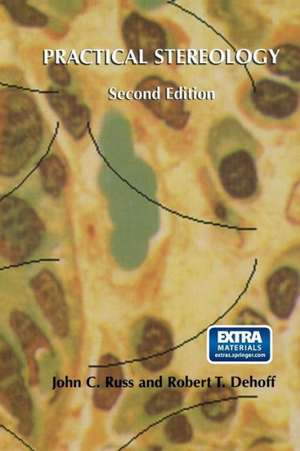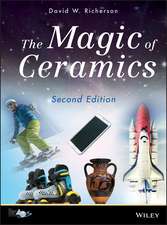Practical Stereology
Autor John C. Russ, Robert T. Dehoffen Limba Engleză Paperback – 26 mar 2013
Preț: 393.90 lei
Nou
Puncte Express: 591
Preț estimativ în valută:
75.37€ • 78.86$ • 62.61£
75.37€ • 78.86$ • 62.61£
Carte tipărită la comandă
Livrare economică 03-17 aprilie
Preluare comenzi: 021 569.72.76
Specificații
ISBN-13: 9781461354536
ISBN-10: 1461354536
Pagini: 396
Ilustrații: X, 381 p.
Dimensiuni: 155 x 235 x 21 mm
Greutate: 0.55 kg
Ediția:2nd ed. 2000
Editura: Springer Us
Colecția Springer
Locul publicării:New York, NY, United States
ISBN-10: 1461354536
Pagini: 396
Ilustrații: X, 381 p.
Dimensiuni: 155 x 235 x 21 mm
Greutate: 0.55 kg
Ediția:2nd ed. 2000
Editura: Springer Us
Colecția Springer
Locul publicării:New York, NY, United States
Public țintă
ResearchCuprins
1: Introduction.- Elements of microstucture.- Geometric properties of features.- Typical stereological procedures.- Fundamental relationships.- Intercept length and grain size.- Curvature.- Second order stereology.- Stereology of single objects.- 2: Basic Stereological Procedures.- What stereology is.- How stereology works.- Why stereology works.- Ground rules for applying stereology.- 3: Geometry of Microstructures.- The qualitative microstructural state.- The quantitative microstructural state.- The topographic microstructural state.- 4: Classical Stereological Measures.- Two-dimensional structures; area fraction from the point count.- Volume fraction from the point count.- Two-dimensional structures; feature perimeter from the line intercept count.- Three-dimensional structures: surface area and the line intercept count.- Three-dimensional microstructures; line length and the area point count.- 5: Less Common Stereological Measures.- Three-dimensional features: topological properties and the volume tangent count.- Three-dimensional features: the mean caliper diameter.- Mean surface curvature and its integral.- The sweeping line probe in two dimensions.- Edges in three-dimensional Microstructures.- 6: Sample Design in Stereology.- Population of point probes.- Population of lines in two dimensions.- Line probes in three dimensions.- Planes in three-dimensional space.- Disectors in three-dimensional space.- Sampling strategies in 3D.- 7: Procedures for IUR Sampling.- Volume fraction.- Sampling planes.- Isotropic planes.- Isotropic line probes.- Volume probes—the Disector.- Networks.- 8: Statistical Interpretation of Data.- Sources of variability in measurement.- Distributions of values.- The mean, median and mode.- The central limit theorem and the Gaussiandistribution.- Variance and standard deviation.- Testing distributions for normality—skew and kurtosis.- Some other common distributions.- Comparing sets of measurements—the T-test.- Nonparametric comparisons.- Linear regression.- Nonlinear regression.- 9: Computer-Assisted Methods.- Getting the image to the computer.- Display and storage.- Image processing.- Overlaying grids onto images.- Basic stereological calculations.- 10: Computer Measurement of Images.- Measurement using grids.- Measuring area with pixels.- Measurement parameters—size.- Other feature measurements: shape and position.- Image processing to enable thresholding and measurement.- Image processing to extract measurable information.- Combining multiple images.- 11: Geometric Modeling.- Methods: analytic and sampling.- Sphere intercepts.- Intercept lengths in other bodies.- Intercept lengths in three dimensions.- Intersections of planes with objects.- Bertrand’s paradox.- The Buffon needle problem.- 12: Unfolding Size Distributions.- Linear intercepts in spheres.- Plane intersections.- Other shapes.- Simpler methods.- Lamellae.- 13: Anisotropy and Gradients.- Grain structures in rolled metals.- Boundary orientation.- Gradients and neighbor relationships.- Distances and irregular gradients.- Alignment.- 14: Finite Section Thickness.- Projected images.- Bias in stereological measurements.- Measurements within sections.- 15: Three-Dimensional Imaging.- Limitations of stereology.- Serial methods for acquiring 3D image data.- Inversion to obtain 3D data.- Stereoscopy as a 3D technique.- Visualization.- Processing.- Measurement.- References.








